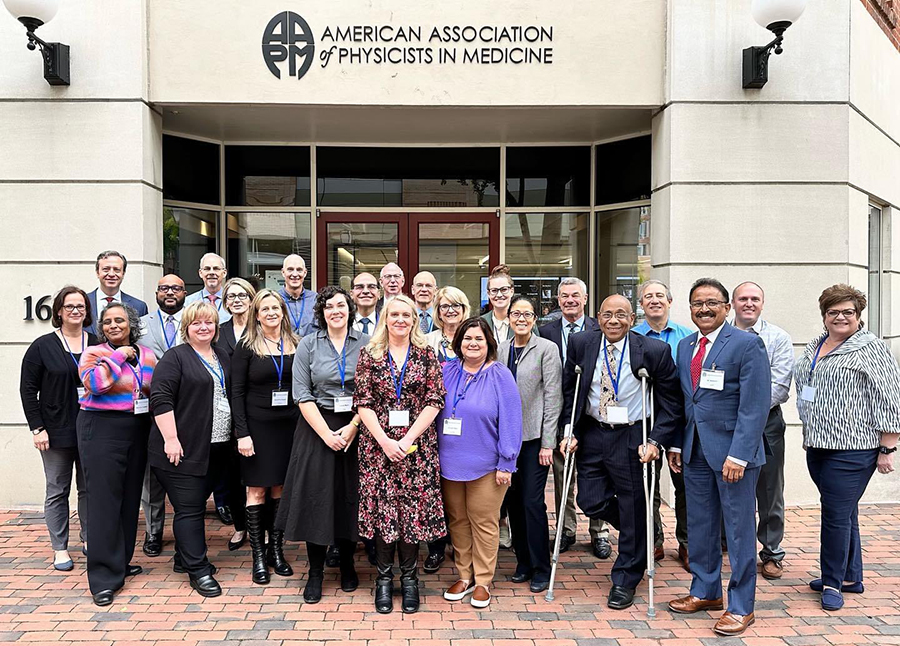News Archive
Thomas L. Morgan, HPS Medical Health Physics Section President
The American Association of Physicists in Medicine (AAPM) held the Quality Measures Roundtable discussion 23 October 2023. I participated as a representative of the Health Physics Society (HPS).
Background
Recently, the Centers for Medicare and Medicaid Services (CMS) proposed a new quality metric as part of the 2024 Inpatient Prospective Payment System Rule. Known as the "Excessive Radiation Dose or Inadequate Image Quality for Diagnostic Computed Tomography in Adults" rule, this measure provides a standardized method for monitoring the performance of diagnostic CT to discourage unnecessarily high radiation doses, a risk factor for cancer, while preserving image quality. It is expressed as a percentage of CT exams that are out-of-range based on having either excessive radiation dose or inadequate image quality relative to evidence-based thresholds based on the clinical indication for the exam.
The American College of Radiology responded with detailed comments, many of which questioned if the current state of the art of medical imaging informatics and a lack of well-defined and accepted definition of "excessive dose" could support this new rule.
This roundtable brought together a broad spectrum of organizational stakeholders with a vested interest in the quality of medical imaging practice. The goal of this roundtable was to form a broad consensus about how the quality, safety, and consistency of medical CT imaging can be assured.
Over the span of some eight hours, individuals from 19 organizations presented thoughts on three questions:
- Where are we now (current state)?
- What is needed?
- How do we get there?
A draft of a consensus document has been prepared and circulated for comment.
HPS Perspective
To avoid unnecessary exposure and risk to patients, there are three main concepts to consider:
- Justification
- Optimization
- Dose limits
The HPS has published several positions relevant to diagnostic medical imaging:
- CT scanning – Computed tomography (CT) screening exams should only be performed if prescribed by a qualified health care provider.
- Radiation exposure of public – No person should be intentionally exposed to ionizing radiation without his or her knowledge.
- Risk – The HPS has concluded that estimates of health risk should be limited to individuals receiving a dose of 50 mSv in one year or a lifetime dose of 100 mSv above that received from natural sources.
- Risk assessment –
- Risk assessments should be consistent, of high technical quality, unbiased, and based on sound, objective science.
- Risk assessments should employ the best available scientific and/or technical data.
- Risk assessments should include consideration of uncertainties.
Takeaways From Roundtable
From the perspective of a radiation protection professional, the following statements from the consensus documents are relevant:
|
Question |
Statements |
|
Quality measures:
|
|
|
Quality measures:
|
|
|
Quality measures:
|
|
HPS Engagement
Much of this effort is beyond the scope of radiation protection, per se. Radiation protection professionals are not directly responsible for medical imaging quality, do not participate in decision making with respect to the appropriateness of medical imaging procedures, and do not set techniques for CT scanners.
However, we are experts in applying the three pillars of radiation protection (justification, optimization, and dose limits). Hence, we have a place at the table. The HPS should remain engaged in this effort by monitoring its progress and providing technical knowledge, expertise, and support where appropriate.
Recommendations
- Educate HPS members on this new rule and efforts by various stakeholders to respond.
- Monitor this effort. Suggest alerting the Medical Health Physics Section, Intersociety Relations Committee, and Government Relations Committee about this effort. Section and committee members should reach out to other stakeholders to offer to participate in this effort.
- Stand ready to appoint appropriate HPS members with appropriate knowledge, experience, and training to joint task forces when requested.
- Consider drafting additional position statement(s) supporting this initiative.
- Consider soliciting abstracts on this effort for the annual HPS meeting.

In-person attendees at the AAPM Quality Measures Roundtable
Photo courtesy of AAPM



